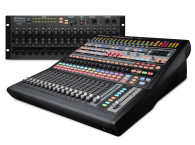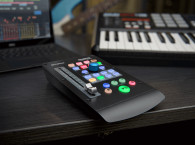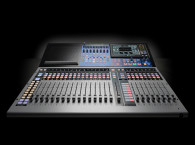
with the StudioLive CS18AI
We first heard of PreSonus adopting the AVB audio networking route at the National Association of Music Merchants (NAMM) 2015, when the company placed AVB stickers all over it’s booth and was demoing Pivitec’s Personal Monitor Mixing System and Ethernet AVB connectivity solutions networked with its own systems. With PreSonus “going AVB” (IEEE 802.1), it’s joining the ranks of Avid, MOTU and others. Clearly, one of the main motivations is directly related with Apple’s unofficial but practical support of AVB on Mac OSX.
Now, with the new StudioLive CS18AI mix controller, PreSonus is able to offer a complete networked solution, centered around this new modular control surface which can be integrated with the relatively new PreSonus StudioLive RM-series rack-mount mixers or can simply expand mixing abilities with PreSonus' Active Integration digital mixers. The most important application, either live or in the studio, will be the integration of all those systems with PreSonus’ DAW solution, Studio One.
Networking with StudioLive RM32AI and RM16AI mixers via AVB Ethernet and PreSonus UCNET technology, the StudioLive CS18AI offers touch-sensitive motorized faders and enables complete hardware control of all mixer features, managing up to 64 channels. The new controller also makes it even easier to do virtual soundcheck, live recording, and studio mixdown with the Studio One DAW and Capture recording software.

“The StudioLive CS18AI is the next logical step as we continue expanding our modular networked mixing systems,” remarkes PreSonus Senior Product Manager Ray Tantzen. “Our StudioLive Active Integration mixing systems are the only solutions that allow you to customize your mixing experience to fit your individual needs. With a StudioLive RM as the mix core, you can choose to work with physical motorized faders, portable wireless iPad, a large Windows 8 touch screen, or a combination of them all.”
The 19", rack-mountable StudioLive CS18AI has the same footprint as a StudioLive 16.4.2AI console and can control up to 64 input channels (with two cascaded StudioLive RM-series mixers) and the mixer’s Fat Channel processing section. An RGB Channel Select button makes it easy to identify and switch between channels.
In addition to supporting traditional “layer” workflows, the new controller supports PreSonus Filter DCA Groups, making it easy and intuitive to navigate and control large mixes with its 18 touch-sensitive, motorized faders. The CS18AI also features a 16-channel scribble-strip display and a 4.3-inch color touchscreen.
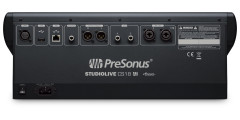
Because the StudioLive CS18AI’s motorized faders are touch-sensitive, we don’t have to move the fader for it to recognize it’s being touched, and we can view the fader value without changing it. When used with Studio One, this enables to write automation using touch-and-latch methods that “know” when you touch and release a fader.
The StudioLive CS18AI can be used concurrently with PreSonus UC Surface control software for Mac, Windows, and iPad and QMix-AI personal monitor control software for iPhone/iPod touch, in order to control StudioLive RM mixer with multiple devices simultaneously. UC Surface integrates directly with the CS18AI as an extension to the physical controller, providing complementary views for the selected channel strip, full metering, and scene recalls.

The StudioLive CS18AI is expected to be available in June 2015 for $2,499.95.
A 32-channel system with 1 StudioLive CS18AI and 1 RM32AI mixer will be available for $4,999.95.
A 64-channel system with 1 StudioLive CS18AI and 2 RM32AI mixers will be available for $7,499.85.
New AVB Networking Card
In order to enable its networkable vision, PreSonus launched its SL-AVB-MIX Audio Video Bridging (AVB) audio networking option card for StudioLive AI-series console and StudioLive RM-series rack-mount Active Integration mixers.
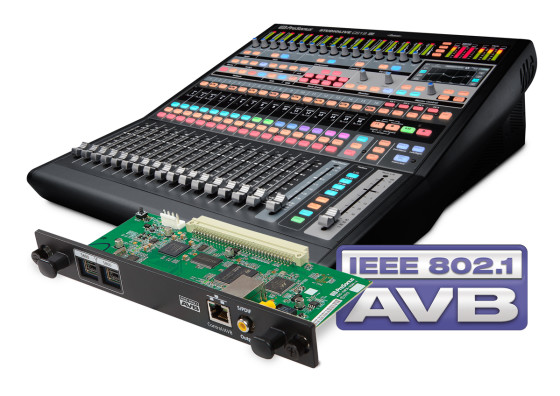
AVB enables precisely synchronized, real-time, low-latency, streaming of audio across an Ethernet network with self-configuring, true plug-and-play convenience. All StudioLive RM-series mixers already have the SL-AVB-MIX option card installed and just need a firmware update to enable the new AVB networking functionality. The card is offered as an upgrade option for StudioLive AI console mixers.
With this first phase of AVB support, PreSonus enabled the use of the StudioLive RM32AI or RM16AI units as a stage box and monitor mixer for any StudioLive AI-series front-of-house (FOH) console mixer. With PreSonus’ Active Integration technology, the mixers on the AVB system can be set up, and all mixing workflows can be synchronized, in a single step. All input routing to and from the onstage RM mixer and the AI console mixer at FOH is configured automatically.
In addition, the talkback and main L/R mix from FOH are set up as the talkback input and main L/R outputs on the RM mixer onstage. The talkback on/off at FOH also engages the talkback onstage, making it easy to communicate with the band. PreSonus Active Integration also keeps scene save and recall in sync between the mixers in the system.
“This is just the beginning of PreSonus AVB networking,” commented Ray Tantzen, Senior Product Manager for PreSonus. “We have big plans to unleash the true power of a networked audio system. Our implementation of AVB will continue to grow, supporting more workflows and more devices from PreSonus and other manufacturers. With more manufacturers getting onboard with AVB, we are very excited about the future.”
The SL-AVB-MIX option card for StudioLive AI Console Mixers is available for $399.95.
www.presonus.com



